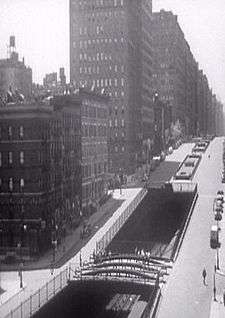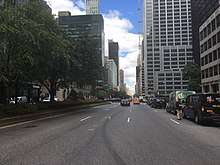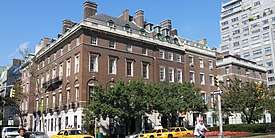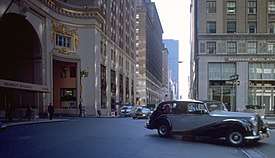Park Avenue
Park Avenue is a wide New York City boulevard[4] which carries north and southbound traffic in the borough of Manhattan. For most of the road's length in Manhattan, it runs parallel to Madison Avenue to the west and Lexington Avenue to the east. Park Avenue's entire length was formerly called Fourth Avenue; the title still applies to the section between the Bowery and 14th Street.[5] The avenue is called Union Square East between 14th and 17th Streets, and Park Avenue South between 17th and 32nd Streets.
| Fourth Avenue, Union Square East, Park Avenue South | |
 Looking south, facing the MetLife Building and with the Waldorf Astoria hotel to the left | |
| Former name(s) | Fourth Avenue |
|---|---|
| Owner | City of New York |
| Maintained by | NYCDOT |
| Length | 10.9 mi[1][2][3] (17.5 km) |
| Location | Manhattan and The Bronx, New York City |
| South end | Astor Place in Cooper Square |
| Major junctions | Park Avenue Tunnel and Viaduct in East Midtown |
| North end | Third Avenue in Fordham |
| East | Lexington Avenue |
| West | Madison Avenue |
| Construction | |
| Commissioned | March 1811 |
History

Early years and railroad construction
Park Avenue was originally known as Fourth Avenue and carried the tracks of the New York and Harlem Railroad starting in the 1830s.[6] The railroad originally ran through an open cut through Murray Hill, which was covered with grates and grass between 34th and 40th Street in the early 1850s. A section of this "park" was later renamed Park Avenue in 1860, and the name was later applied to the segment between Union Square and 42nd Street.[7]
The Harlem Railroad was later incorporated into the New York Central Railroad, and a terminal for the New York Central at 42nd Street, the Grand Central Depot, opened in 1871.[8]:3 But the tracks laid to the new terminal proved problematic. There were originally no grade-separated crossings of the railroads between 42nd and 59th Streets.[9] As such, they required railroad crossings along Fourth Avenue, which resulted in frequent accidents; seven people died within 12 days of the Hudson River Railroad's move to Grand Central.[10]
In 1872, shortly after the opening of Grand Central Depot, New York Central owner Cornelius Vanderbilt proposed the Fourth Avenue Improvement Project.[8] The tracks between 48th and 56th Streets were to be moved into a shallow open cut,[11] while the segment between 56th and 97th Streets, which was in a rock cut, would be covered over.[8][lower-alpha 1] After the improvements were completed in 1874, the railroads, approaching Grand Central Depot from the north, descended into the Park Avenue Tunnel at 96th Street and continued underground into the new depot.[8] As part of the project, Fourth Avenue was transformed into a boulevard with a median strip that covered the railroad's ventilation grates.[13][14][8]:4 Eight footbridges crossed the tracks between 45th and 56th Streets, and there were also vehicular overpasses at 45th and 48th Streets.[8]:4 The boulevard north of Grand Central was renamed Park Avenue in 1888.[15]
Grand Central and Terminal City
A fatal collision between two trains occurred under Park Avenue in 1902, in part because the smoke coming from the steam trains obscured the signals.[16][17] The New York state legislature subsequently passed a law to ban all steam trains in Manhattan.[18] By December 1902, as part of an agreement with the city, New York Central agreed to put the approach to Grand Central Station from 46th to 59th Streets in an open cut under Park Avenue, and to upgrade the tracks to accommodate electric trains. Overpasses would be built across the open cut at most of the cross-streets.[19] The new electric-train terminal, Grand Central Terminal, was opened in 1913.[20]
After the electric trains were buried underground, the area around Park Avenue in the vicinity of Grand Central was developed into several blocks worth of prime real estate called Terminal City. Stretching from 42nd to 51st Streets between Madison and Lexington Avenues, it came to include the Chrysler Building and other prestigious office buildings; luxury apartment houses along Park Avenue; and an array of high-end hotels that included the Marguery, Park Lane, and Waldorf Astoria.[21] In 1929, New York Central built its headquarters in a 34-story building (now called the Helmsley Building), straddling Park Avenue north of the terminal.[22]
The Park Avenue Viaduct reroutes Park Avenue around Grand Central Terminal between 40th and 46th Streets, allowing Park Avenue traffic to traverse around the building and over 42nd Street without encumbering nearby streets.[23] The western (now southbound) leg of the viaduct was completed in 1919,[24] but congestion developed soon after the viaduct's opening, so an eastern leg for northbound traffic was added in 1928.[23]
Later years
In 1927, the medians on Park Avenue north of Grand Central were trimmed to add one lane of traffic in each direction. This project eliminated the pedestrian path on the medians, as they became much narrower. The median was extended by one block from 96th Street to 97th Street in 1941, creating the only remaining median on Park Avenue with a pedestrian path and seating.[25] In the 1920s the portion of Park Avenue from Grand Central to 96th Street saw extensive apartment building construction. This long stretch of the avenue contains some of the most expensive real estate in the world. Real estate at 740 Park Avenue, for example, sells for several thousand dollars per square foot.[26]
In October 1937, a part of the Murray Hill Tunnel was reopened for road traffic. Efforts to promote a Grand Park Avenue Expressway to Grand Concourse in the Bronx were unsuccessful.[27]
A tradition was introduced in 1945 as a memorial to American soldiers killed in action, whereby Christmas trees are placed in the median and lit up on the first Sunday in December at Brick Presbyterian Church.[28] On May 5, 1959, the New York City Council voted 20–1 to change the name of Fourth Avenue between 17th and 32nd Streets to Park Avenue South. The renaming, along with a ban on overhanging signs along the newly renamed Park Avenue South, was intended to improve the character of the avenue.[29] The Pan Am Building (now MetLife Building), in between the Park Avenue Viaduct's legs north of Grand Central Terminal, was opened in 1963.[30]
On March 12, 2014, two apartment buildings near 116th Street, 1644 and 1646 Park Avenue, were destroyed in a gas explosion. Eight people were killed and many others were injured.[31]
Route

Manhattan
The road that becomes Park Avenue originates at the Bowery. From Cooper Square at 8th Street to Union Square at 14th Street, it is known as Fourth Avenue, a 70-foot-wide (21 m) road carrying northbound traffic. At 14th Street, it turns slightly northeast to align with other avenues drawn up in the Commissioners' Plan of 1811. From 14th Street to 17th Street, it forms the eastern boundary of Union Square and is known as Union Square East; its southbound lanes merge with Broadway south of 15th Street, and the thoroughfare divides into two distinct portions in the one-block section between 14th and 15th Streets. From 17th Street to 32nd Street, it is known as Park Avenue South. Above 32nd Street, for the remainder of its distance, it is known as Park Avenue, a 140-foot-wide boulevard.[2]
Between 33rd Street and 40th Street, the left-hand northbound lane descends into the Murray Hill Tunnel. Immediately across from 40th Street, the center lanes of Park Avenue rise onto an elevated structure that goes around Grand Central Terminal and the MetLife Building (formerly the PanAm Building), carrying each direction of traffic on opposite sides of the buildings. The bridge, one of two structures in Manhattan known as the Park Avenue Viaduct, returns to ground level at 46th Street after going through the Helmsley Building (also referred to as the New York Central Building or 230 Park Avenue).[2] The IRT Lexington Avenue Line runs under this portion of the street. Once the line reaches Grand Central–42nd Street, it shifts east to Lexington Avenue.

As Park Avenue enters Midtown north of Grand Central Terminal, it is distinguished by many glass-box skyscrapers that serve as headquarters for corporations and investment banks such as Société Générale, JPMorgan Chase at 270 Park Avenue and 277 Park Avenue, UBS at 299 Park Avenue, Citigroup, Colgate-Palmolive, and MetLife at the MetLife Building.[2] Prior to July 2010, the eleven intersections between 46th Street and 56th Street lacked the city's usual pedestrian crossing signals and overhead gantry-mounted traffic lights, because the railroad tunnel ceiling, which is also the street, was not thick enough for their poles' foundations. (These intersections did, however, have upright pole-mounted traffic lights prior to 2010, but there were no pedestrian signals. After 2010, standard gantry-mounted traffic lights and pedestrian "countdown" signals were installed.)[32][33]
From 47th to 97th Streets, Metro-North Railroad tracks run in a tunnel underneath Park Avenue (the Park Avenue Tunnel). At 97th Street, the tracks come above ground, rising onto the other Manhattan structure known as the Park Avenue Viaduct. The first street to pass under the viaduct is 102nd Street; from there to the Harlem River the railroad viaduct runs down the middle of Park Avenue. Park Avenue in Manhattan ends north of 132nd Street, with connections to the Harlem River Drive.[2]
The flowers and greenery in the median of Manhattan's Park Avenue are privately maintained, by the Fund for Park Avenue. The begonia was specifically chosen by the Fund's gardeners because there is no automatic watering system and the floral variety is resilient under hot sun rays.[34]
The Bronx
The avenue is continued on the other side of the river in the Bronx. In the Bronx, Park Avenue begins at East 135th Street in the Mott Haven neighborhood. The entire avenue is divided by Metro-North's own right of way in the borough. Between East 135th Street to East 173rd Street, Park Avenue is one way only in either direction in most sections. North of East 173rd Street it is a two way avenue continuing to Fordham Plaza where it ends.[3]
Businesses
The following institutions are either headquartered or have significant business presences on Park Avenue:
|
Notable structures
In north-south order:[2]
- Daryl Roth Theatre
- 44 Union Square
- Everett Building, 200 Park Avenue South
- W New York Union Square, 201 Park Avenue South
- 225 Park Avenue South
- Church Missions House, 281 Park Avenue South
- United Charities Building, 287 Park Avenue South
- 300 Park Avenue South
- Metropolitan Life North Building, 324 Park Avenue South
- New York Life Building, 364–378 Park Avenue South
- 2 Park Avenue –designed by Ely Jacques Kahn
- 3 Park Avenue
- Scandinavia House, 58 Park Avenue
- Pershing Square Building, 125 Park Avenue
- Grand Central Terminal (actually in Park Avenue, between the Park Avenue Viaduct's two roadways)
- MetLife Building, 200 Park Avenue
- Helmsley Building, 230 Park Avenue
- 245 Park Avenue
- 270 Park Avenue
- 277 Park Avenue
- 299 Park Avenue
- Waldorf Astoria New York, 301 Park Avenue
- St. Bartholomew's Episcopal Church
- 345 Park Avenue
- Racquet and Tennis Club, 370 Park Avenue
- Seagram Building, 375 Park Avenue –designed by Mies van der Rohe
- Lever House, 390 Park Avenue –designed by Gordon Bunshaft
- 399 Park Avenue
- 432 Park Avenue
- Halstead Property, 499 Park Avenue
- Central Presbyterian Church, 593 Park Avenue
- 620 Park Avenue
- 655 Park Avenue
- Harold Pratt House, 58 East 68th Street (corner of Park Avenue)
- Park Avenue Houses
- Percy R. Pyne House, 680 Park Avenue (now the Americas Society)
- Oliver D. Filley House, 684 Park Avenue (now the Queen Sofía Spanish Institute)
- William Sloane House, 686 Park Avenue (now the Italian Cultural Institute of New York)
- Henry P. Davison House, 690 Park Avenue (now the Italian Consulate General)
- Asia Society, 725 Park Avenue
- 740 Park Avenue
- 970 Park Avenue
- Church of St. Ignatius Loyola, 980 Park Avenue
- 1000 Park Avenue
- Park Avenue Christian Church, 1010 Park Avenue
In popular culture
- Will Smith, as a policeman, pursues a criminal by jumping off the Park Avenue Viaduct in the 1997 film Men in Black.
- In the 1988 film Cocktail, Tom Cruise visits the wealthy father of Elizabeth Shue's character, Jordan, who lives on Park Avenue at 67th street.
- In the 2007 film I Am Legend, Will Smith again appears on the Park Avenue Viaduct, where his character is captured by a vampire's snare.
- In the 2012 film The Avengers, the climax takes place on the Park Avenue Viaduct.
- In the TV series The Odd Couple, Felix Unger and Oscar Madison live at 1049 Park Avenue.
- In the TV series Diff'rent Strokes, Phillip Drummond, with his daughter, Kimberly and adopted sons, Willis and Arnold Jackson live at 697 Park Avenue.
- In The Simpsons episode "E-I-E-I-D'oh", Homer is ridiculed by two farmers outside Sneed's Feed & Seed (Formerly Chuck's) for having a "Park Avenue manicure". Homer responds by saying "I'm sorry, I believe in good grooming".
- The PBS documentary Park Avenue: Money, Power and the American Dream sheds light on the gap between the impoverished people living on Park Avenue in the South Bronx and the extremely wealthy living at 740 Park Avenue in Manhattan.
- In the song "Youth Gone Wild" by American band Skid Row, Park Avenue is mentioned in the lyrics: "I said 'Hey man, there's something that you oughta know. / I tell ya Park Avenue leads to Skid Row.'"
- The stage and film musical How to Succeed in Business Without Really Trying takes place in the fictional "Park Avenue office building of World Wide Wicket Company, Inc."
- General Motors borrowed the name of the street for the Buick Park Avenue, a large luxury sedan that was produced first as the premium trim line for the Buick Electra from 1977 to 1990, and as a standalone model from 1991 to 2005.
- In the intro to the late 1960s - early 1970s TV show Green Acres, Eva Gabor's character sings "Darling I love you, but give me Park Avenue!", where she lived before moving to rural Hooterville with her husband, the lawyer-turned-farmer.[35]
- The song "Puttin' On the Ritz", from the film Blue Skies (1946), refers to affluent people strutting "up and down Park Avenue".
- In the 2017 video game Sonic Forces, one of the main stage takes place on Park Avenue, the stage re-imagined as a war zone.
- In the second season of Riverdale, one of the main characters from the show, Veronica Lodge is said to have lived on Park Avenue when she was back in New York City.
- In the multi-platinum 1989 hit single Youth Gone Wild the lyrics of the song have a famous line that says "I'll tell ya Park Avenue leads to Skid Row"
Gallery
 Henry P. Davison House, Percy Rivington Pyne House, Oliver D. Filley House and William Sloane House is one of the original house ensembles left on Park Avenue
Henry P. Davison House, Percy Rivington Pyne House, Oliver D. Filley House and William Sloane House is one of the original house ensembles left on Park Avenue Park Avenue and 47th Street, adjacent to the Helmsley Building
Park Avenue and 47th Street, adjacent to the Helmsley Building
 10 Park Avenue, at the corner of East 34th Street
10 Park Avenue, at the corner of East 34th Street The Adelaide L. Townsend Douglas House, currently the Guatemalan U.N. Mission at 57 Park Avenue, between East 37th and 38th Streets
The Adelaide L. Townsend Douglas House, currently the Guatemalan U.N. Mission at 57 Park Avenue, between East 37th and 38th Streets
References
Explanatory notes
- The line entered fully enclosed brick tunnels between 67th and 71st Streets, and between 80th and 96th Streets. The remainder of this segment was located in a "beam tunnel" structure, which were mostly open-air, except where cross-streets traversed the cut on steel-beam bridges.[12]
Citations
- Google (September 10, 2015). "Fourth Avenue and Union Square East" (Map). Google Maps. Google. Retrieved September 10, 2015.
- Google (September 10, 2015). "Park Avenue (Manhattan)" (Map). Google Maps. Google. Retrieved September 10, 2015.
- Google (September 10, 2015). "Park Avenue (The Bronx)" (Map). Google Maps. Google. Retrieved September 10, 2015.
- Gray, Christopher (May 12, 2002). "Streetscapes:903 Park Avenue, at 79th Street". The New York Times.
- New York City Geographic Information Systems map
- Gray, Christopher (March 3, 2013). "Before There Was a 'Grand' in Central". The New York Times. Retrieved October 15, 2015.
- Gray, Christopher (July 24, 2011). "Putting the Park in Park Avenue". The New York Times. Retrieved October 15, 2015.
- Fitch, James Marston; Waite, Diana S. (1974). Grand Central Terminal and Rockefeller Center: A Historic-critical Estimate of Their Significance. Albany, New York: The Division.
- "THE RAILROAD TRAP.; Another Day's Scenes at the Grand Central Depot". The New York Times. November 18, 1871. Retrieved December 4, 2018.
- "RAILROAD ABUSES.; Official Investigation into the Grand Central Depot Nuisance. Scenes and Incidents at the Crossings Yesterday.Search for the Missing Dead Only One Out of the Seven Said to be Killed Yet Found The Coroners and the PoliceUtterly in the Dark. The Dangers that Centre Around the New Vanderbilt Depot What the Officials Say Minor Inconveniences". The New York Times. October 1, 2018. Retrieved December 4, 2018.
- "The State Capital; Rapid Transit of Railroad Bills in the Assembly". New York Herald. April 24, 1872. p. 13. Retrieved December 6, 2018 – via newspapers.com.

- Robins, A.W.; New York Transit Museum (2013). Grand Central Terminal: 100 Years of a New York Landmark. ABRAMS. p. 85. ISBN 978-1-61312-387-4. Retrieved December 6, 2018.
- Reitano, J. (2018). The Restless City: A Short History of New York from Colonial Times to the Present. Taylor & Francis. p. 278. ISBN 978-1-134-81048-2. Retrieved December 4, 2018.
- "Grand Central Terminal". East Side Access in New York, Queens, and Bronx Counties, New York, and Nassau and Suffolk Counties, New York: Environmental Impact Statement. East Side Access in New York, Queens, and Bronx Counties, New York, and Nassau and Suffolk Counties, New York: Environmental Impact Statement. 2001. p. 3. Retrieved December 4, 2018.
- Gray, Christopher (March 17, 2002). "Streetscapes: 709 and 711 Park Avenue, Between 69th and 70th Streets; When Park Ave. Was 4th, and Not Socially Correct". The New York Times. Retrieved October 15, 2015.
- "FIFTEEN KILLED IN REAR END COLLISION; Trains Crash in Darkness of Park Avenue Tunnel. TWO SCORE ARE INJURED Engineer Disregards or Fails to See Signals. LOCOMOTIVE BURIED IN CAR Firemen Cut Their Way Into the Wreck and Climb Over the Hot Boiler to the Aid of the Wounded -- Heroic Acts of Rescuers and Rescued -- Survivors and Others Tell Thrilling Stories of Their Experiences". The New York Times. January 9, 1902. Retrieved December 10, 2018.
- "Fifteen Killed, Thirty-Six Hurt". New-York Tribune. January 9, 1902. p. 1. Retrieved December 10, 2018 – via newspapers.com.

- Sprague, J. L.; Cunningham, J. J. (2013). "A Frank Sprague Triumph: The Electrification of Grand Central Terminal [History]". IEEE Power and Energy Magazine. Institute of Electrical and Electronics Engineers (IEEE). 11 (1): 58–76. doi:10.1109/mpe.2012.2222293. ISSN 1540-7977.
- "NEW YORK CENTRAL TO ACCEPT CITY'S PLANS; Station, Tunnel, and Other Improvements to Cost $25,000,000. Park Avenue to be Opened, Bridges Built at Cross Streets, Electricity Introduced, and Grade Crossings Abolished". The New York Times. December 27, 1902. Retrieved December 10, 2018.
- Maranzani, Barbara. "Grand Central Terminal: An American Icon". History.com. Retrieved February 2, 2018.
- Gray, Christopher (August 19, 2010). "Covering Its Tracks Paid Off Handsomely". The New York Times. Retrieved December 10, 2018.
- "Park Avenue, Interrupted". The New York Times. December 21, 2014. Retrieved December 8, 2018.
- "New Viaduct Thoroughfare Relieves Park Avenue Traffic Congestion; Result of Many Years' Work" (PDF). The New York Times. September 2, 1928. p. Real Estate, Page 123. Retrieved December 7, 2018.
- "Link Up Park Av. to Ease Congestion". The New York Times. April 17, 1919. Retrieved December 7, 2018.
- Kadinsky, Sergey (October 24, 2017). "Park Avenue's Hidden History". Forgotten-NY. Retrieved October 25, 2017.
- Rogers, Teri Karush (October 9, 2005). "Peeking Behind the Gilded Walls of 740 Park Ave". The New York Times. Retrieved August 15, 2007.
- "Park Avenue Express Highway (NY 22, unbuilt)". Nycroads.com. February 14, 1935. Retrieved October 8, 2012.
- Kilgannon, Corey (December 3, 2010). "Park Ave. Christmas Lights Go Up, and Xiao Ye Closes". The New York Times.
- Bennett, Charles G. (May 6, 1959). "Sign Ban Is Voted on Two Avenues". The New York Times. p. 41. Retrieved July 31, 2010.
- Gray, Christopher (October 7, 2001). "Streetscapes/The MetLife Building, Originally the Pan Am Building; Critics Once Called It Ugly; Now They're Not Sure". The New York Times. Retrieved September 30, 2015.
- Santora, Marc & Rashbaum, William K. "Rescue Effort in East Harlem Yields Only More Victims". New York Times. Retrieved March 13, 2014.
- Neuman, William (September 22, 2007). "It's a Deal: Help for Park Ave. Pedestrians". The New York Times. Retrieved February 24, 2012.
- Goodman, Jillian; Rovzar, Chris (July 7, 2010), "City Finally Installs Crossing Signals on Park Avenue Above Grand Central", New York, retrieved February 24, 2012
- Pollak, Michael (July 16, 2006). "Why Yellow Takes the Wheel". The New York Times. Retrieved July 31, 2010.
- Green Acres Intro, retrieved November 27, 2019
Further reading
- "Park Avenue Historic District" (PDF). New York City Landmarks Preservation Commission. April 29, 2014.
External links
| Wikimedia Commons has media related to Park Avenue. |
- New York Songlines: Fourth Avenue with The Bowery and Park Avenue, a virtual walking tour
- Classic Apartments Buildings and Architecture of Park Avenue Images & History